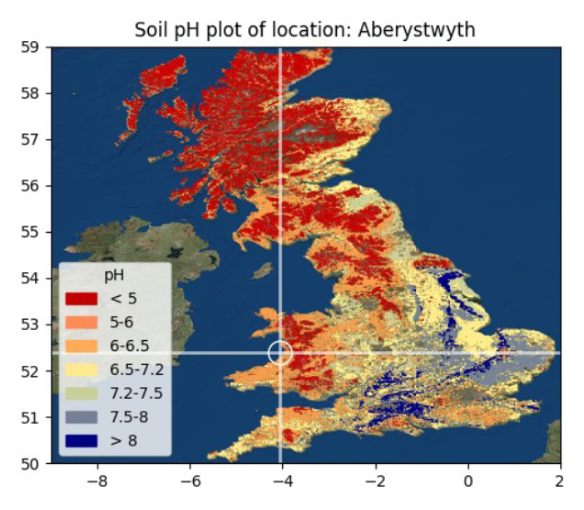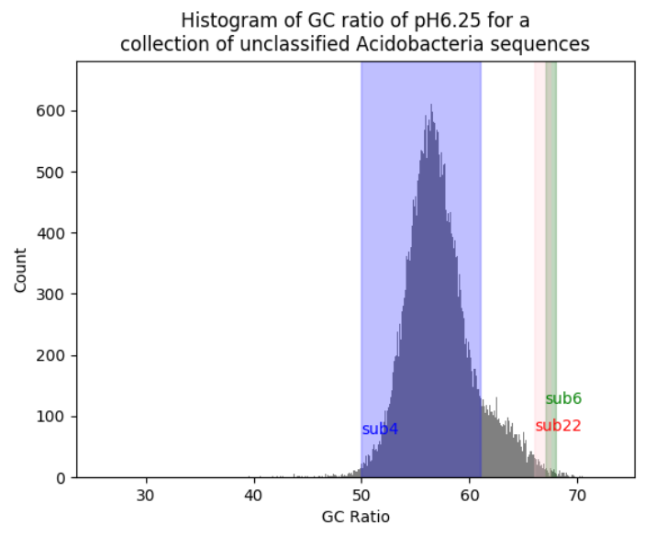Dr Samantha Pendleton
Clinical Informatician
Engineer of data, ontologies, and clusters. Thrower of pots, controllers, and eggs.
Acidoseq
Acidoseq is a tool for studing metagenomic reads, grouping Acidobacteria classified and unclassified reads into subdivisons based on GC content.
It is a Python package, designed for Nanopore sequences, available open-source on GitHub with a condensed paper.
This work was a part of my Masters degree (2018), which the dissertation is available to read.
The motivation behind development of this package was due to many of Acidobacteria’s recovered sequences were labelled as “unclassified”.
The GC content of the Acidobacteria genomes are consistent with their placements.
For example, those in the subdivisions V have a GC content of above 60% and those in subdivisions III is roughly 10% lower.
This highlights both the diversity and patterns within the phylum1.
Moreover, the abundance of the subdivisions correlate with the pH. For example subdivisions 4, 6, 7, 10, 11, 16, 17, 18, 22, and 25 are sparse in low pH and more dense as pH increases2. Whereas this is the opposite for subdivisions 1, 2, 3, 12, and 13.
In order to “predict” these unclassified reads into a subdivision, acidoseq uses both GC content and soil pH levels.
Acidoseq features includes a plot to represent subdivisions, the GC content for DNA stability tests, and a map of soil pH levels in the UK.
Users need to use Kaiju3 which classifies metagenomes with taxon IDs: thus labelling those classified or not.
Futhermore, users need to know the pH of the soil, if unknown, there is a map plotting function which users simply input a town/city and then manually derive the pH. Note: due to the spherical Earth and maps being 2-dimensional, there is some minor distortion when plotting locations.
Testing included data extracted from soil in Aberystwyth.
$ acidoseq --taxdumptype U --kaijufile result_seqid_taxon.csv --fastapath all.fa --style seaborn --plottype span --ph 6.25
Using the mapping function, I inferred soil pH levels at 6.25 (see the Figure below).

Figure: Feature of Acidoseq to plot the UK soil pH levels.
Then after running acidoseq on the unclassified reads, we see that many reads are divided into subdivisions 4, 6, and 22 as one would expect with this pH (see the Figure below).

Figure: The GC content and subdivison visualiation of the reads.
We then ran the unclassified reads though BLAST4 to see annotations/alignments.
From the BLAST output, we see reads aigned to subdivisions 6 and 4: there was presence of Luteitalea pratensis (90.91%) which resides in subdivision 6 and Pyrinomonas methylaliphatogenes strain K22 which resides in subdivision 4.
References
Quaiser, Achim, et al. “Acidobacteria form a coherent but highly diverse group within the bacterial domain: evidence from environmental genomics.” Molecular microbiology 50.2 (2003): 563-575. ↩︎
Eichorst, Stephanie A., et al. “Isolation and characterization of soil bacteria that define Terriglobus gen. nov., in the phylum Acidobacteria.” Applied and environmental microbiology 73.8 (2007): 2708-2717. ↩︎
Menzel, P., Ng, K. L., & Krogh, A. (2016). Fast and sensitive taxonomic classification for metagenomics with Kaiju. Nature communications, 7(1), 11257. ↩︎
Altschul, Stephen F., et al. “Basic local alignment search tool.” Journal of molecular biology 215.3 (1990): 403-410. ↩︎